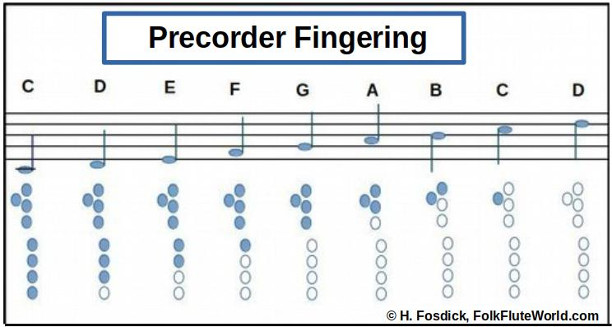by Howard Fosdick © FolkFluteWorld.com.
Recorders dominate early childhood music education the United States. For good reason: they're child-safe, inexpensive, durable, portable, washable, and tunable. They're also true musical instruments. They play two full octaves with all sharps and flats.
Perhaps most importantly, it's easy to start playing a recorder. They're a simple, keyless flute. You don't have to learn proper embouchure like you do with a transverse flute. You just put your mouth on the mouthpiece and blow. Tons of learning materials are freely available for learning recorder on the internet.
But recorders aren't perfect. If you've ever witnessed grade schoolers starting out with them, you'll know about the infamous "recorder squeak." And all the other weird sounds they somehow produce. Younger children have difficulty fully covering the holes with consistency to voice notes. Half-holing the octave key is totally beyond them. While the recorder is universally regarded as easy to play, that's not strictly true for many primary school children.
For this reason, several companies have sought to redesign the instrument into something more approachable for the youngest children. Suzuki invented their Precorder for this very reason.
This article reviews the Precorder. What are its strengths and weaknesses? Does it offer a viable alternate to the venerable recorder in grade school education? Should you buy your child one? We'll explore these issues and more.
The Instrument
The Precorder is a lightweight, hollow plastic flute. It's end-blown, just like the recorder. And like the recorder, it has 7 holes topside and one thumbhole beneath. The last two right-hand holes are double-holes, to make it easy to play low C# and low D# / E♭.

Suzuki Precorder (Courtesy of Suzuki)
The Precorder package includes a nice totebag with drawstring, a neckstrap, a large-print fingering chart, and some Suzuki stickers.
Improvements
The Precorder fits young hands better than a recorder. It's only about 10 inches long with a total span of 4 inches between the topside holes. In contrast, most of my soprano recorders measure about 12.5 inches long, with a finger span of about 5 to 6 inches between the holes.
Very importantly, the Precorder has raised finger holes. This ensures youngsters will cleanly cover the holes to clearly sound notes and avoid squeaks. This principle has been successfully proven over many years in the Flutophone and the Song Flute.
Another Precorder advantage for young players is that its fingering is easier than the recorder. Take a look at the fingering chart:

Precorder Fingering (By the author)
As you can see, there is no forked F or middle-finger high C. Fingering is simply "straight up the ladder." (I've left accidentals out of this chart to demonstrate the easy whole-note fingering.)
The price of this simplified fingering is a limited range of only 9 whole notes. The goal here is ease of use for very young children. The trade-off is that this is a "musical toy" rather than an adult instrument with a full range like the recorder.
I find the Precorder has a very pleasant tone. It's neither shrill nor a "cheap plastic flute" sound. It's quite good for a very inexpensive flute.
One minor defect: I've found the highest note, D, can best be attained by the "acute bend" technique. Just bend the flute slightly downwards to hit high D precisely. Young children may not be able to hit this note.
Recommendation
My feeling is that the Precorder is an attractive alternative to recorder for the very youngest children. It's inexpensive and well-designed for its target audience. At only around $10, it's well worth it as a throw-away musical toy / instrument. As children age, they'll migrate to a standard recorder, or perhaps a concert instrument.
For comparison, you might like to see my articles on the Flutophone and Song Flute.
***** SUMMARY *****
Instrument: Suzuki Plastic PrecorderCompany: Suzuki
Tuning: C major
Range: C5-D6 including all sharps and flats
Measurements: apx 10" length, 1 1/4" maximum width
Includes: draw-string carrying bag, a neckstrap, fingering chart, and stickers
Cost: Varies, usually about $10